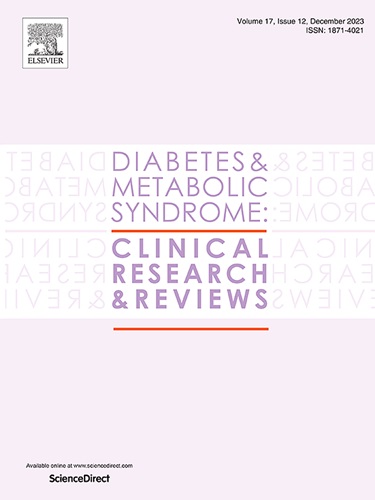Is myopia associated with a reduced or increased risk of diabetic retinopathy? A systematic review and meta-analysis
IF 3.4
Q1 ENDOCRINOLOGY & METABOLISM
Diabetes & Metabolic Syndrome-Clinical Research & Reviews
Pub Date : 2025-06-01
DOI:10.1016/j.dsx.2025.103253
引用次数: 0
Abstract
Introduction
Diabetic retinopathy remains a leading cause of vision loss worldwide. Recent studies suggest that myopia, particularly due to axial elongation, may offer a protective effect against retinal microvascular damage.
Objectives
This systematic review and meta-analysis aimed to evaluate the association between myopia and diabetic retinopathy, quantify the strength of this relationship, and explore potential protective mechanisms.
Methods
A systematic search of PubMed, Embase, Cochrane, and other databases was conducted in accordance with PRISMA guidelines. Eight observational studies including 5564 individuals with type 1 or type 2 diabetes were analyzed. Pooled odds ratios (OR) were computed using a random-effects model. Subgroup and heterogeneity analyses were also performed.
Results
Moderate myopia was significantly associated with an 80 % lower risk of diabetic retinopathy (OR = 0.20, 95 % CI: 0.11–0.37, p < 0.00001). High myopia showed a 31.5 % reduced risk compared to moderate myopia (OR = 0.685, 95 % CI: 0.607–0.773). Hyperopia was associated with a nearly fivefold higher risk of vision-threatening diabetic retinopathy (OR = 4.874, 95 % CI: 4.677–5.078). There was no significant heterogeneity (I2 = 0 %) and minimal evidence of publication bias.
Conclusion
Moderate and high myopia appear to be protective against diabetic retinopathy, likely due to axial length-related anatomical changes. These findings could inform future diabetic eye disease risk models and personalized screening strategies.
近视与糖尿病视网膜病变风险的降低或增加有关吗?系统回顾和荟萃分析
糖尿病视网膜病变仍然是世界范围内视力丧失的主要原因。最近的研究表明,近视,特别是由于轴向伸长,可能对视网膜微血管损伤有保护作用。本系统综述和荟萃分析旨在评估近视与糖尿病视网膜病变之间的关系,量化这种关系的强度,并探讨潜在的保护机制。方法按照PRISMA指南系统检索PubMed、Embase、Cochrane等数据库。8项观察性研究包括5564例1型或2型糖尿病患者。采用随机效应模型计算合并优势比(OR)。还进行了亚组分析和异质性分析。结果中度近视与糖尿病视网膜病变风险降低80%显著相关(OR = 0.20, 95% CI: 0.11-0.37, p <;0.00001)。与中度近视相比,高度近视的风险降低31.5% (OR = 0.685, 95% CI: 0.607-0.773)。远视与威胁视力的糖尿病视网膜病变的风险增加近5倍相关(OR = 4.874, 95% CI: 4.677-5.078)。没有显著的异质性(I2 = 0%)和最小的发表偏倚证据。结论中、高度近视可能与眼轴长度相关的解剖改变有关,对糖尿病视网膜病变具有保护作用。这些发现可以为未来的糖尿病眼病风险模型和个性化筛查策略提供信息。
本文章由计算机程序翻译,如有差异,请以英文原文为准。
求助全文
约1分钟内获得全文
求助全文
来源期刊

Diabetes & Metabolic Syndrome-Clinical Research & Reviews
ENDOCRINOLOGY & METABOLISM-
CiteScore
22.90
自引率
2.00%
发文量
248
审稿时长
51 days
期刊介绍:
Diabetes and Metabolic Syndrome: Clinical Research and Reviews is the official journal of DiabetesIndia. It aims to provide a global platform for healthcare professionals, diabetes educators, and other stakeholders to submit their research on diabetes care.
Types of Publications:
Diabetes and Metabolic Syndrome: Clinical Research and Reviews publishes peer-reviewed original articles, reviews, short communications, case reports, letters to the Editor, and expert comments. Reviews and mini-reviews are particularly welcomed for areas within endocrinology undergoing rapid changes.
 求助内容:
求助内容: 应助结果提醒方式:
应助结果提醒方式:


